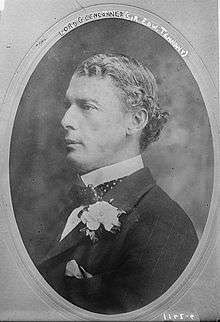Edward Tennant, 1st Baron Glenconner


Edward Priaulx Tennant, 1st Baron Glenconner (31 May 1859 – 21 November 1920), known as Sir Edward Tennant, 2nd Baronet, from 1906 to 1911, was a Scottish Liberal politician.
The eldest surviving son of Sir Charles Tennant, 1st Baronet, he was educated at Eton College and at Trinity College, Cambridge.[1] He married Pamela Wyndham, a writer, and had several children.
Tennant travelled extensively in Africa, India, and America, and was Assistant Private Secretary to Sir George Otto Trevelyan, Secretary for Scotland, from 1892-1895. He was unsuccessful parliamentary candidate for Partick in 1892 and for Peebles and Selkirk in 1900. He was elected as Liberal Member of Parliament for Salisbury at the 1906 general election, holding the seat until the 1910 general election.
He succeeded his father to the baronetcy in 1906, and in 1911 he was raised to the peerage as Baron Glenconner, of The Glen in the County of Peebles. Lord Glenconner was also Lord High Commissioner to the General Assembly of the Church of Scotland in 1911, 1912, 1913 and 1914, and served as Lord Lieutenant of Peeblesshire from 1908 to 1920.
Other notable members of the family
- Harold Tennant, brother
- Margot (Tennant) Asquith, sister, wife of Prime Minister H. H. Asquith
- Edward Wyndham Tennant, son, war poet
- Stephen Tennant, son
- Clare Tennant, daughter
- David Pax Tennant, son, founder of the Gargoyle Club, husband of Hermione Baddeley
- Colin Tennant, 3rd Baron Glenconner, grandson, developer of the island of Mustique
- Emma Tennant, granddaughter
- Pauline Tennant, granddaughter
- Elizabeth Bibesco, niece
- Anthony Asquith, nephew
Notes
- ↑ "Tennant, Edward Priaulx (TNNT878EP)". A Cambridge Alumni Database. University of Cambridge.
References
- Kidd, Charles, Williamson, David (editors). Debrett's Peerage and Baronetage (1990 edition). New York: St Martin's Press, 1990,
- Leigh Rayment's Peerage Pages
- Leigh Rayment's Historical List of MPs
External links
- Hansard 1803–2005: contributions in Parliament by Edward Tennant
| Parliament of the United Kingdom | ||
|---|---|---|
| Preceded by Sir Walter Palmer |
Member of Parliament for Salisbury 1906–1910 |
Succeeded by Godfrey Locker-Lampson |
| Honorary titles | ||
| Preceded by The Lord Elibank |
Lord Lieutenant of Peeblesshire 1908–1920 |
Succeeded by The Lord Carmichael |
| Baronetage of the United Kingdom | ||
| Preceded by Charles Clow Tennant |
Tennant Baronets 1906–1920 |
Succeeded by Christopher Grey Tennant |
| Peerage of the United Kingdom | ||
| Preceded by New Creation |
Baron Glenconner 1911–1920 |
Succeeded by Christopher Grey Tennant |
